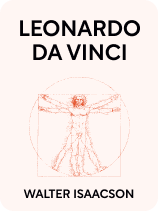

This article is an excerpt from the Shortform book guide to "Leonardo da Vinci" by Walter Isaacson. Shortform has the world's best summaries and analyses of books you should be reading.
Like this article? Sign up for a free trial here.
What can we learn from Leonardo da Vinci’s legacy? Do you want to know how to think like Leonardo da Vinci?
Leonardo da Vinci is considered one of the greatest artists of all time. Walter Isaacson’s biography of the painter, scientist, and engineer provides lessons that you can apply to be more like Leonardo.
Keep reading to learn how to think like Leonardo da Vinci.
Leonardo’s Lessons
While Leonardo’s particular genius was unique, you can replicate it by nurturing the same natural inclinations and leaning carefully into the same flaws. To learn how to think like Leonardo da Vinci, Isaacson extracts lessons from Leonardo that you can apply to be more like the Renaissance genius:
- Nurture an insatiable, child-like curiosity.
- Learn because it gives you pleasure, not because you need to.
- Pay attention to details.
- Let your imagination run free.
- Don’t be afraid of distractions or procrastination if they feed your creativity.
- Use critical thinking and experimentation to find the facts.
- Use visuals to understand complex ideas.
- Find the intersections between different subjects and areas.
- Seek perfection.
- Seek collaboration.
- Don’t let money dictate your passions.
- Write things down (even your to-do lists).
- Appreciate the mysteries you can’t delineate with sharp lines.
Shortform Suggestions to Help you Apply Leonardo’s Lessons
These books from the Shortform library offer more guidance to think like Leonardo da Vinci:
- In Big Magic, Elizabeth Gilbert explains that you can practice “gentle inquisitiveness” to see where your interests lead you and how they can feed your creativity.
- You can follow the approach Scott Young outlines in Ultralearning to design a personal learning project about an interest you want to learn more about: Conduct meta-learning research, create a schedule, follow your plan, analyze your results, and create a follow-up plan to retain everything you’ve learned.
- If you struggle with details, try doing one of your daily activities in slow motion, as Bhante Gunaratana recommends in Mindfulness in Plain English. Slow down to 10X the time it takes you to do an activity and pay full attention to each component.
- The voices of critics can stifle your imagination. To make sure they don’t put out your creative fire, follow Stephen King’s advice in On Writing: Write (or do any creative activity) with the door closed, literally and metaphorically. This will help you block out the outside world and create for yourself, rather than worrying about what others think.
- If you feel guilty about procrastinating and getting distracted, remember what Austin Kleon advises in Steal Like an Artist: The time you spend on hobbies and being bored improves your creativity because it encourages your mind to make new connections.
- In Principles, Ray Dalio suggests keeping your eye on two hurdles for finding the facts: your ego and your blindspots. To avoid letting them get in the way, look at your mistakes as proof that you’re learning, and frame your search for facts as the search for the best possible answer, not for the best answer you can come up with.
- You don’t have to be an artist to use visuals. In Make it Stick, Peter Brown, Henry Roediger, and Mark McDaniels explain that using illustrations and images helps you understand and retain new concepts. They also suggest examining multiple examples and problems at the same time to find common threads.
- One way to make striving for perfection manageable is to ask yourself “How can I do better today?” As David Schwartz explains in The Magic of Thinking Big, this will prompt you to find daily opportunities for improvement. He also suggests seeking out collaboration by always asking more questions than you answer and by offering your views in the form of questions to elicit feedback from others.
- Money didn’t dictate Leonardo’s passions, but it did dictate where his career could take him. To make sure you can build a career you love and also have a steady financial base, follow the eight steps Vicki Robin and Joe Dominguez outline in Your Money or Your Life: Understand the flow of money in your life, align your spending with your values and goals, graph and increase your income, cut spending, and invest.
- In The Bullet Journal Method, Ryder Carroll also advocates for writing things down, even when technological alternatives seem more efficient. He argues that analog writing such as in a bullet journal can help you get organized, live in the present, find clarity on what’s important to you, and see your progress through time.
- To tap into Leonardo’s appreciation for mystery, you might get inspiration from the Tao Te Ching, which explains that some things can’t be understood, only experienced. To engage with the inexplicable, keep your thoughts simple, be patient with others, and be compassionate toward yourself.

———End of Preview———
Like what you just read? Read the rest of the world's best book summary and analysis of Walter Isaacson's "Leonardo da Vinci" at Shortform.
Here's what you'll find in our full Leonardo da Vinci summary:
- A detailed look into the life, accomplishments, and struggles of Leonardo da Vinci
- Lessons from his life and work that you can apply to your own life
- What set Leonardo apart from other artists at the time






